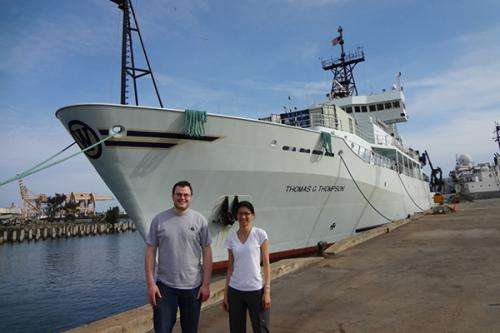Microbe quest: Geologist investigates microbial communities at underwater volcano near Hawaii

Hawaii was created by underwater volcanoes that gradually built upwards during eruptions until they popped out above the ocean. The next island to form is waiting 3,000 feet underwater as a seamount named Loihi, which occasionally rumbles out earthquakes and should surface hundreds of thousands of years from now.
Until then, Loihi's inhabitants are not hula girls and hibiscus flowers, but rather bacteria and other microbes. The University of Delaware's Clara Chan, assistant professor of geological sciences in the College of Earth, Ocean, and Environment, and graduate student Sean McAllister are on a 17-day research cruise there to study these microbial communities and their roles in this unusual setting.
Chan and her colleagues are aboard the research vessel Thomas G. Thompson to retrieve samples from pulpy, orange, bacteria-laden mats that grow at near hydrothermal vents, or cracks in the seamount where heat and chemicals are released from within the earth. The bacteria produce the mats as they consume iron and excrete a rusty waste product.
The scientists are using the remotely operated vehicle Jason II to suck up the microbes with a slurp gun and bring them back up to the ship for analysis.
Chan previously traveled to the site in 2006 and 2008 with a team that discovered these iron-oxidizing bacteria, or Zetaproteobacteria, were present and active. Since then, the microbes have been found in coastal saltmarshes, corroding steel and deep-ocean crust.
"We call ourselves 'Zeta hunters,' because we're searching for more of these," Chan said.
Zetaproteobacteria tend to thrive in marine environments where there are gradients of iron and oxygen. Deeper and deeper inside the Loihi mats, for example, there is increasingly more dissolved iron and less oxygen.
"This is how we know they're active, because there are gradients," Chan said.
She is trying to understand how these organisms make iron oxides, which take shape as microscopic stalks and sheaths. The distinct structures form the building blocks of the mats, which in turn house other microbes in a small ecosystem.
"They form an apartment building for other organisms to live in," Chan said.
The researchers are investigating how the microbial community functions as a whole, with organisms living together and doing different jobs for each other. Zetaproteobacteria also fix carbon, for example, which can provide food for other organisms.
During this trip, the researchers will try to pinpoint different populations of Zetaproteobacteria, which can be identified by their DNA, as well as the shape of the iron oxide structures they form. Using the slurp gun captures too large a volume, so they will take a more targeted approach.
"It's like sampling an entire city at once, and trying to learn the function of each group of citizens," Chan said. "You don't know who does what."
Instead of taking several liters of the mats, they'll use a smaller tool to take 100 milliliters or less at a time to sample specific mat populations. The researchers will also examine the metabolism of organisms living in the mats and look for connections to the surrounding chemistry.
This field of science is called biogeochemistry, in which scientists study the interconnections between biology, geology and chemistry within an environment. Chan and her colleagues want to know the bacteria's structures to better understand the microfossil record—and be able to quickly look at biominerals and understand conditions and metabolisms associated with making them.
"Zetaproteobacteria are a prime example of how microbes can fundamentally influence geochemical cycling and mineral deposition," Chan said. "The structures they create can also be identified in fossils, perhaps informing us of environments from Earth's past."
This research is supported by a grant from the National Science Foundation. The crew is posting updates from sea at zetahunters.wordpress.com and returns on April 1.
Provided by University of Delaware




















